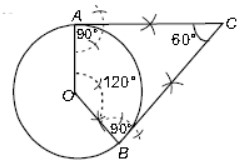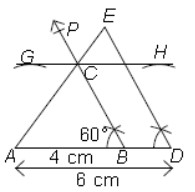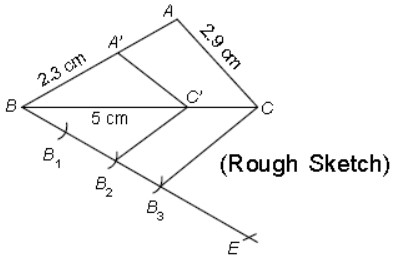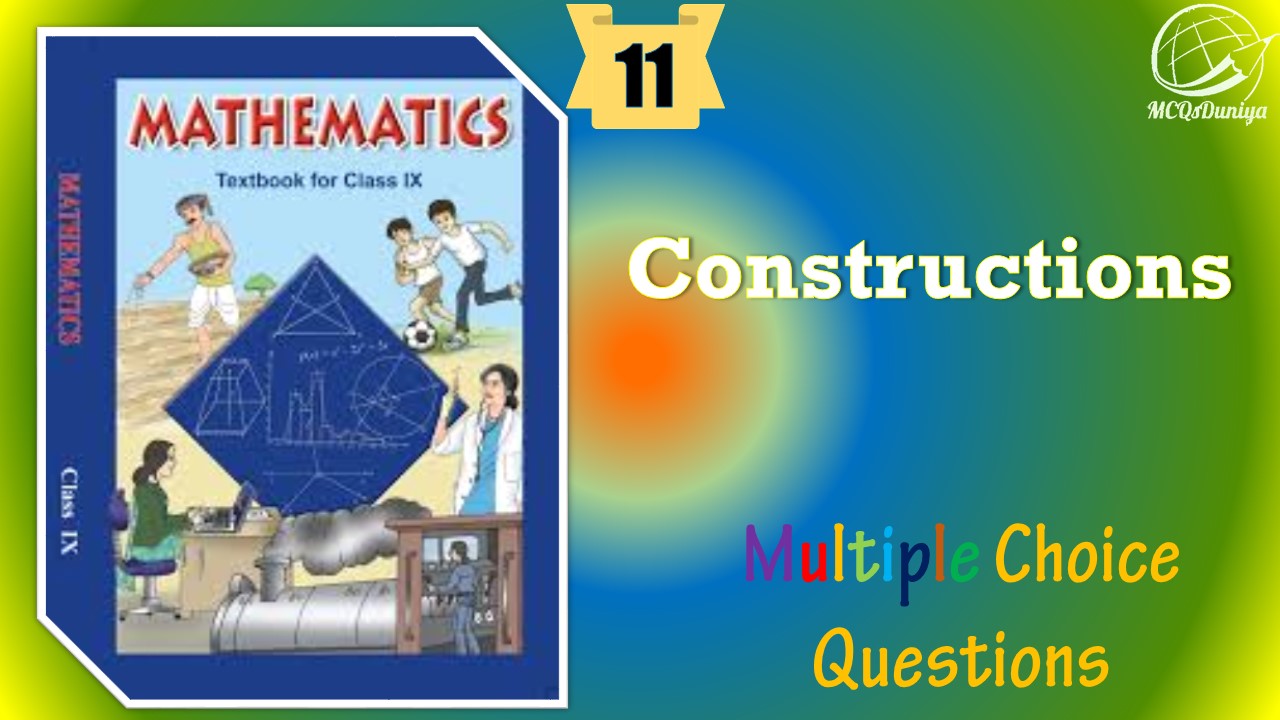Class 9 Mathematics MCQ Constructions with Answers is Prepared Based on Latest Exam Pattern. Students can solve NCERT Class 9 Mathematics MCQ Constructions with Answers to know their preparation level.
Students who are searching for NCERT Class 9 Mathematics MCQ Constructions with Answers are compiled here to get good practice on all fundamentals. Know your preparation level on MCQ Questions for Class 9 Mathematics MCQ Constructions with Answers. You can also verify your answers from the provided Class 9 Mathematics MCQ Constructions with Answers. So, ace up your preparation with MCQ of Class 9 Mathematics MCQ & NCERT Textbook solutions Examinations.
NCERT Class 9 Mathematics MCQ Constructions with Answers
Question : With the help of a ruler and a compass, it is possible to construct an angle of
(a) 40°
(b) 37.5°
(c) 47.5°
(d) 35°
Answer :(b) 37.5°Show Answer :
Question : To construct an angle of 60 degrees, we need to draw first:
(a) A ray
(b) An arc
(c) Two rays
(d) A straight line
Answer :(a) A rayShow Answer :
Question : Which of the following set of lengths can be the sides of a triangle?
(a) 2 cm, 4 cm, 1.9 cm
(b) 5.5 cm, 6.5 cm, 8.9 cm
(c) 1.6 cm, 3.7 cm. 5.3 cm
(d) Non e of those
Answer :(b) 5.5 cm, 6.5 cm, 8.9 cmShow Answer :
Question : Two radii of same circle are always :
(a) may inchired at any angle
(b) perpendicular
(c) parallel
(d) parallel and may inchired at any angle
Answer :(d) parallel and may inchired at any angleShow Answer :
Question : A rotating ray after making a complete rotation coincides with its initial position. The angle thus formed is
(a) reflex angle
(b) straight angle
(c) right angle
(d) complete angle
Answer :(d) complete angleShow Answer :
Question : The construction of a triangle ABC with AB = 4 cm and ∠A = 60° is not possible when difference of BC and AC is equal to
(a) 3.5 cm
(b) 4.5 cm
(c) 2.5 cm
(d) 3 cm
Answer :(b) 4.5 cmShow Answer :
Question : If a, b and c are the lengths of three sides of a triangle, then:
(a) a + b > c
(b) a – b > c
(c) a + b = c
(d) a – b = c
Answer :(a) a + b > cShow Answer :
Question :On a ray AB with initial point A, Taking A as centre and some radius, draw an arc of a circle, which intersects AB, say at a point D. Taking D as centre and with the same radius as before, draw an arc intersecting the previously drawn arc, say at a point E. Draw the ray AC passing through E. Then, the measure of ∠CAB is
(a) 30°
(b) 60°
(c) 45°
(d) 15°
Answer : (b) 60°Show Answer :
Question :An angle whose measure is more than 180° and less than 360° is called a
(a) Reflex angle
(b) Acute angle
(c) Straight angle
(d) Complete angle
Answer : (a) Reflex angleShow Answer :
Question :With the help of a ruler and compass, it is possible to construct an angle of
(a) 40°
(b) 37.5°
(c) 65°
(d) 50°
Answer : (b) 37.5°Show Answer :
Question :Which of the following angles can be constructed using ruler and compasses?
(a) 35°
(b) 45°
(c) 95°
(d) 55°
Answer : (b) 45°Show Answer :
Question :In Δ ABC if ∠B = ∠C = 300, which of the following is the longest side?
(a) BC
(b) AC
(c) AB
(d) none
Answer : (a) BCShow Answer :
Question :An external bisector of an angle measuring 70° will divide the angle into two angles measuring
(a) 35°
(b) 55°
(c) 70°
(d) 110°
Answer : (b) 55°Show Answer :
Question :On a ray AB with initial point A, Taking A as centre and some radius, draw an arc of a circle, which intersects AB, say at a point D. Taking D as centre and with the same radius as before, draw an arc intersecting the previously drawn arc, say at a point E. Draw the ray AC passing through E. Then, the measure of ∠CAB is
(a) 15°
(b) 30°
(c) 45°
(d) 60°
Answer : (d) 60°Show Answer :
Question :The point of concurrence of the three angle bisectors of a triangle, is called
(a) Centroid
(b) Incentre
(c) Circumcentre
(d) Orthocentre
Answer : (b) IncentreShow Answer :
Question :The construction of a triangle ABC with AB = 4 cm and ∠A = 60° is not possible when difference of BC and AC is equal to
(a) 3.5 cm
(b) 4.5 cm
(c) 2.5 cm
(d) 3 cm
Answer : (b) 4.5 cmShow Answer :
Question :Which of these angles cannot be constructed using ruler and compasses?
(a) 120°
(b) 60°
(c) 140°
(d) 135°
Answer : (c) 140°Show Answer :
Question :The internal and external bisectors of an angle form a
(a) Acute angle
(b) Straight angle
(c) Right angle
(d) Reflex angle
Answer : (c) Right angleShow Answer :
Question :The bisector of an angle lies in its
(a) Interior
(b) On the arms of the angle
(c) Any where in the plane
(d) Exterior
Answer : (a) InteriorShow Answer :
Question : With the help of a ruler and a compass, it is possible to construct an angle of
(a) 40°
(b) 37.5°
(c) 47.5°
(d) 35°
Answer :(b) 37.5°Show Answer :
Question : Which of the following angles can be constructed using ruler and compasses?
(a) 35
(b) 45
(c) 95
(d) 55
Answer :(b) 45Show Answer :
Question : If we want to construct a triangle, given its perimeter, then we need to know:
(a) Sum of two sides of triangle
(b) Difference between two sides of triangle
(c) One base angles
(d) Two base angles
Answer :(c) One base anglesShow Answer :
Question : With the help of a ruler and compass, it is possible to construct an angle of
(a) 40°
(b) 37.5°
(c) 65°
(d) 50°
Answer :(b) 37.5°Show Answer :
Question : An angle whose measure is more than 180° and less than 360° is called a
(a) Reflex angle
(b) Acute angle
(c) Straight angle
(d) Complete angle
Answer :(a) Reflex angleShow Answer :
Question : Which of the following angles can be constructed using ruler and compass?
(a) 35°
(b) 40°
(c) 90°
(d) 50°
Answer :(c) 90°Show Answer :
Question : If a, b and c are the lengths of three sides of a triangle, then:
(a) a+b>c
(b) a-b>c
(c) a+b=c
(d) a-b=c
Answer : (i) a+b>cShow Answer :
Question : Which of the following set of lengths can be the sides of a triangle?
(a) 2 cm, 4 cm, 1.9 cm
(b) 1.6 cm, 3.7 cm, 5.3 cm
(c) 5.5 cm, 6.5 cm, 8.9 cm
(d) None of the above
Answer :(c) 5.5 cm, 6.5 cm, 8.9 cmShow Answer :
Question : An angle whose measure is more than 180° and less than 360° is called a
(a) Reflex angle
(b) Acute angle
(c) Straight angle
(d) Complete angle
Answer :(a) Reflex angleShow Answer :
Question : Two radii of the same circle are always:
(a) may inchired at any angle
(b) parallel
(c) parallel and may inchired at any angle
(d) perpendicular
Answer :(c) parallel and may inchired at any angleShow Answer :
Question :Two radii of the same circle are always:
(a) may inchired at any angle
(b) parallel
(c) parallel and may inchired at any angle
(d) perpendicular
Answer : (c) parallel and may inchired at any angleShow Answer :
Question :In Δ ABC, which of the following information is needed to construct it if it is known that measure of ∠B = 60 and BC = 6 cm :
(a) AB + BC
(b) CA + AB
(c) BC + CA
(d) All of the above
Answer : (d) All of the aboveShow Answer :
Question :With the help of a ruler and a compass, it is possible to construct an angle of
(a) 40°
(b) 37.5°
(c) 47.5°
(d) 35°
Answer : (b) 37.5°Show Answer :
Question :The construction of △ABC, given that BC = 5 cm, ∠B = 600 is not possible when the difference of AB and AC is equal to
(a) 4.2 cm
(b) 5.9 cm.
(c) 4 cm.
(d) 3 cm.
Answer : (b) 5.9 cm.Show Answer :
Question :Which of the following angles can be constructed using ruler and compass?
(a) 35°
(b) 40°
(c) 90°
(d) 50°
Answer : (c) 90°Show Answer :
Question :Two radii of same circle are always :
(a) may inchired at any angle
(b) perpendicular
(c) parallel
(d) parallel and may inchired at any angle
Answer : (d) parallel and may inchired at any angleShow Answer :
Question :If two circles touches internally then distance between their centres is equal to
(a) sum of radii
(b) difference of radii
(c) not possible to determine
(d) none
Answer : (b) difference of radiiShow Answer :
Question : Which of the following angles can be constructed using ruler and compasses?
(a) 35°
(b) 45°
(c) 95°
(d) 55°
Answer :(b) 45°Show Answer :
Question : The side lengths 4cm, 4cm and 4cm can be sides of:
(a) Scalene Triangle
(b) Isosceles Triangle
(c) Equilateral Triangle
(d) None of the above
Answer : (iii) Equilateral TriangleShow Answer :
Question : An external bisector of an angle measuring 70° will divide the angle into two angles measuring
(a) 35°
(b) 55°
(c) 70°
(d) 110°
Answer :(b) 55°Show Answer :
Question : The bisector of an angle lies in its
(a) Interior
(b) On the arms of the angle
(c) Any where in the plane
(d) Exterior
Answer :(a) InteriorShow Answer :
Question : The construction of △ABC, given that BC = 5 cm, ∠B = 600 is not possible when the difference of AB and AC is equal to
(a) 4.2 cm
(b) 5.9 cm.
(c) 4 cm.
(d) 3 cm.
Answer :(b) 5.9 cm.Show Answer :
Question : Which of the following set of lengths can be the sides of a triangle?
(a) 2 cm, 4 cm, 1.9 cm
(b) 1.6 cm, 3.7 cm. 5.3 cm
(c) 5.5 cm, 6.5 cm, 8.9 cm
(d) None of the above
Answer : cShow Answer :
Question : The side lengths 4cm, 4cm and 4cm can be sides of:
(a) Scalene Triangle
(b) Isosceles Triangle
(c) Equilateral Triangle
(d) None of the above
Answer : cShow Answer :
Explanation: Equilateral triangle has all its three sides equal.
Question : To construct a bisector of a given angle, we need:
(a) A ruler
(b) A compass
(c) A protractor
(d) Both ruler and compass
Answer : dShow Answer :
Question : Arrange the following steps of construction while constructing a pair of tangents to circle, which are inclined to each other at an angle of 60° to a circle of radius 3 cm.Steps of ConstructionStep I : Draw any diameter AOB of this circle
Step II : Draw AM ⊥ AB and CN ⊥ OC. Let AM and CN intersect each other at P. Then PA and PC are the desired tangents to the given circle, inclined at an angle of 60°.
Step III : Draw a circle with O as centre and radius 3 cm.
Step IV : Construct ∠BOC = 60° such that radius OC meets the circle at C.
(a) III, I, IV, II
(b) III, II, IV, I
(c) II, I, IV, III
(d) IV, II, III, I
Answer :AShow Answer :
Question : Arrange the following steps of construction while constructing a pair of tangents to a circle of radius 3 cm from a point 10 cm away from the centre of the circle.Steps of ConstructionStep I : Bisect the line segment OP and let the point of bisection be M.
Step II : Taking M as centre and OM as radius, draw a circle. Let it intersect the given circle at the point Q and R.
Step III : Draw a circle of radius 3 cm.
Step IV : Join PQ and PR.
Step V : Take an external point P which is 10 cm away from its centre. Join OP.
(a) III, V, I, II, IV
(b) III, I, V, IV, II
(c) III, V, I, IV, II
(d) III, V, II, I, IV
Answer :AShow Answer :
Question :Let ABC be a right triangle in which AB = 3 cm, BC = 4 cm and ∠B = 90°. BD is the perpendicular from B on AC. The circle through B, C, D is drawn. Given below are the steps of constructions of a pair of tangents from A to this circle. Which of the following steps is INCORRECT? Steps of ConstructionStep I : Draw DABC and perpendicular BD from B on AC.
Step II : Draw a circle with BC as a diameter. This circle will pass through D.
Step III : Let O be the mid-point of BC. Join AO.
Step IV : Draw a circle with AO as diameter. This circle cuts the circle drawn in step II at B and P. AO, AP and AB are desired tangents drawn from A to the circle passing through B, C and D.
(a) Only Step I
(b) Only Step II
(c) Only Step III
(d) Only Step IV
Answer 😀Show Answer :
Question : Given below are the steps of construction of a pair of tangents to a circle of radius 6 cm from a point on the concentric circle of radius 8 cm. Find which of the following steps is INCORRECT? Steps of Construction Step I : Take a point O on the plane paper and draw a circle of radius OA = 6 cm. Also, draw a concentric circle of radius OB = 8 cm.
Step II : Find the mid-point A of OB and draw a circle of radius BA = AO. Suppose this circle intersects the circle of radius 6 cm at P and Q.
Step III : Join BP and BQ to get the desired tangents.
(a) Step I
(b) Step II
(c) Step I and Step II
(d) Step II and Step III
Answer :BShow Answer :
Question : Given below are the steps of construction of a pair of tangents to a circle of radius 6 cm which are inclined to each other at an angle of 60°. Find which of the following step is wrong? Steps of Construction
I. With centre O and radius = 6 cm, draw a circle.

II. Taking a point A on the circle and draw ∠AOB = 120°.
III. Draw a perpendicular on OA at A. Draw another perpendicular on OB at B.
IV. Let the two perpendiculars meet at C. Thus CA and CB are the two required tangents to the given circle which are inclined to each other at 120°.
(a) Only Step I
(b) Only Step II
(c) Only Step III
(d) Only Step IV
Answer 😀Show Answer :
Question :Given below are the steps of construction of two tangents to the circle (without using the centre of the circle ) of radius 4 cm from point P. Which of the following steps is INCORRECT?Steps of ConstructionStep I : Draw a circle of radius 4 cm and take a point P outside the circle and draw a secant PAB, intersecting the circle at A and B.
Step II : Produce AP to C such that AP = CP. Draw a semicircle with CB as diameter.
Step III : Draw PD ⊥ CB, intersecting the semicircle at D. With P as centre and PC as radius draw arcs to intersect the given circle at T and T′.
Step IV : Join PT and PT′. Then, PT and PT′ are the required tangents.
(a) Only Step I
(b) Both Step I and Step II
(c) Only Step III
(d) Both Step II and Step IV
Answer :CShow Answer :
Question : Arrange the following steps of construction for constructing a Δ ABC in which AB = 4 cm, ∠B = 60° and altitude CL = 3 cm and then construct Δ ADE similar to Δ ABC such that each side of Δ ADE is 3/2 times that of the corresponding side of Δ ABC.
Steps of Construction
Step I : Join CA. Thus, D ABC is obtained.

Step II : Draw DE||BC, cutting AC produced at E.
Step III : Extend AB to D such that
Step III : AD = 3/2 AB = (2/3X4)CM = 6CM
Step IV : Draw a line segment AB = 4 cm.
Step V : Draw a line GH||AB at a distance of 3 cm, intersecting BP at C.
Step VI : Construct ∠ABP = 60°
(a) IV, VI, V, I, III, II
(b) IV, V, VI, I, III, II
(c) IV, V, I, III, II, VI
(d) V, IV, VI, III, I, II
Answer :AShow Answer :
Question : Given below are the steps of construction a triangle ABC with side BC = 6 cm, ∠B = 60°, ∠A = 105°and a triangle whose sides are (3/2) times the corresponding sides of Δ ABC. Which of the following steps of construction is INCORRECT?

Steps of ConstructionStep I : Draw BC = 6 cm.
Step II : At B construct ∠CBX = 60° and at C construct ∠BCY = 180° – (60° – 105°) = 15° Suppose BX and CY intersect at A. Δ ABC so obtained is the given triangle.
Step III : Construct an obtuse angle ∠CBZ at B on opposite side of vertex A of Δ ABC.
Step IV : Mark-off three (greater 3 of 2 in 3/2) points B1, B2, B3, on BZ such that BB1 = B1B2 = B2B3.
Step V : Join B2 (the second point) to C and draw a line through B3 parallel to B2C, intersecting the extended line Segment BC at C′.
Step VI : Draw a line through C′ parallel to CA intersecting the extended line segment BA at A′. Triangle A′BC′ so obtained is the required triangle such that A’B/AB = BC’/BC = A’C’/AC = 3/2(A) Step III
(b) Step IV
(c) Step V
(d) Step II
Answer :AShow Answer :
Question :Which of the following steps of construction is INCORRECT while dividing a line segment of length 3.2 cm in the ratio of 3 : 5 internally. Steps of Construction
Step I : Draw AB = 3.2 cm
Step II : Construct an acute ∠BAX.
Step III : On AX make 3 + 5 + 1 i.e. 9 equal parts and mark them as A1, A2, A3, A4, ……. A9
Step IV : Join B to A8. From A3 draw A3C parallel to A8B. Point C divides AB internally in the ratio 3 : 5.
Thus, AC : CB = 3 : 5.
(a) Step II
(b) Step III
(c) Step IV
(d) None of these
Answer :BShow Answer :
Question : Arrange the following steps of construction while constructing a triangle of scale AB = 2.3 cm, BC = 5 cm and AC = 2.9 cm such that each of its sides is 2/3 rd of the corresponding side of the ΔABC. Steps of Construction

Step I : On BE, cut off 3 equal parts making B1, B2 and B3.
Step II : Now, draw C′A′ parallel to CA. Then, DA′BC′ is the required D whose sides are 2/3 rd of the corresponding sides of the ΔABC.
Step III : From point B draw an arc of 2.3 cm and from point C draw an arc of 2.9 cm cutting each other at point A.
Step IV : Take BC = 5 cm.
Step V : Join B3C and from B2 draw B2C′ parallel to B3C, such that BC′ is 2/3 of BC.
Step VI : On B make an acute ∠CBE downwards.
Step VII : Join AB and AC. Then ABC is the required triangle.
(a) IV, III, VII, I, VI, V, II
(b) IV, V, I, VI, III, VII, II
(c) IV, III, VII, VI, I, V, II
(d) IV, VII, III, VI, V, I, II
Answer :CShow Answer :
Question : Arrange the steps of construction while constructing pair of tangents to a circle of radius 5 cm from a point 12 cm away from its centre.Steps of ConstructionStep I : Join OA and bisect it. Let P is the mid-point of OA.
Step II : Join AB and AC. AB and AC are the required tangents. Length of tangents = 11 cm.
Step III : With O as centre, draw a circle of radius 5 cm.
Step IV : Taking P as centre and PO as radius, draw a circle intersecting the given circle at the points B and C.
Step V : Take a point A at a distance of 12 cm from O.
(a) III, V, I, IV, II
(b) III, V, IV, I, II
(c) II, V, IV, III, I
(d) III, IV, II, I, III
Answer :AShow Answer :
Question : Arrange the following steps of construction while dividing a line segment of length 8 cm internally in the ratio 3 : 4.Steps of ConstructionStep I : Draw a ray BY parallel to AX by making ∠ABY equal to ∠BAX.
Step II : Join A3B4. Suppose it intersects AB at a point P. Then, P is the point dividing AB internally in the ratio 3 : 4.
Step III : Draw the line segment AB of length 8 cm.
Step IV : Mark of three point A1, A2, A3 on AX and 4 points B1, B2, B3, B4 on BY such that AA1 = A1A2 = A2A3 = BB1 = B1B2 = B2B3 = B3B4.
Step V : Draw any ray AX making an acute angle ∠BAX with AB.
(a) III, V, I, II, IV
(b) III, IV, I, V, II
(c) III, I, V, IV, II
(d) III, V, I, IV, II
Answer 😀Show Answer :
Question : Which of the following steps is INCORRECT to construct a tangent to the circle of radius 5 cm at the point P on it without using the centre of the circle.Steps of ConstructionStep I : Draw a circle of radius 5 cm.
Step II : Mark a point P on it.
Step III : Draw any chord PQ.
Step IV : Take a point R in the minor arc QP.
Step V : Join PR and RQ.
Step VI : Make ∠QPT = ∠PRQ.
Step VII : Produce TP to T . Then, PT is the required tangent at P.
(a) Step II
(b) Step IV
(c) Step VI
(d) None of these
Answer :BShow Answer :
Question : To construct an angle of 60 degrees, we need to draw first:
(a) A ray
(b) An arc
(c) Two rays
(d) A straight line
Answer : aShow Answer :
Explanation: To construct an angle of 60 degrees we need to start at the initial point of a ray.
Question : If we want to construct a triangle, given its perimeter, then we need to know:
(a) Sum of two sides of triangle
(b) Difference between two sides of triangle
(c) One base angles
(d) Two base angles
Answer : dShow Answer :
Question : With the help of a ruler and a compass, it is possible to construct an angle of
(a) 35°
(b) 37.5°
(c) 40°
(d) 47.5°
Answer :bShow Answer :
Explanation: With the help of a ruler and compass, it is possible to construct an angle of 37.5°.
Question : With the help of a ruler and a compass it is not possible to construct an angle of
(a) 22.5°
(b) 37.5°
(c) 40°
(d) 67.5°
Answer : cShow Answer :
Explanation: With the help of a ruler and a compass it is possible to construct the angles of 22.5°, 30°, 45°, 60° etc. (i.e)multiples of 15° and its angle bisector. Hence, it is not possible to construct a 40° angle using a ruler and compass.
Question : The construction of a triangle ABC in which AB = 4 cm, ∠A = 60° is not possible when the difference of BC and AC is equal to
(a) 2.5 cm
(b) 3 cm
(c) 3.5 cm
(d) 4.5 cm
Answer :dShow Answer :
Explanation: Among the options given, 4.5 >4, since the difference of any two sides of a triangle cannot be greater than the third side.
Question : A triangle ABC with AB = 4 cm and ∠A= 60° and ∠B= 40° is constructed. Then what is the measurement of ∠C?
(a) 40°
(b) 60°
(c) 80°
(d) 100°
Answer :cShow Answer :
Explanation:
By using the angle sum property of a triangle,
∠A+∠B+∠C = 180°
60°+40°+∠C = 180°
∠C = 180°-100°= 80°.
Question : The construction of a triangle ABC, given that BC = 6 cm, ∠B = 45° is not possible when the difference of AB and AC is equal to:
(a) 4 cm
(b) 5 cm
(c) 5.2 cm
(d) 6.9 cm
Answer :dShow Answer :
Explanation: Among the options given, 6.9>6, since the difference of any two sides of a triangle cannot be greater than the third side.
Question : Which of these triangles are possible to construct by knowing only its altitude?
(a) Right angled triangle
(b) Equilateral triangle
(c) Isosceles triangle
(d) Any triangle
Answer :(b) Equilateral triangleShow Answer :
Question : Which of these angles cannot be constructed using ruler and compasses?
(a) 120°
(b) 60°
(c) 140°
(d) 135°
Answer :(c) 140°Show Answer :
Question : Which of the following angles can be constructed using ruler and compass?
(a) 35
(b) 40
(c) 90
(d) 50
Answer :(c) 90Show Answer :
Question : In Δ ABC, which of the following information is needed to construct it if it is known that measure of ∠B = 60 and BC = 6 cm :
(a) AB + BC
(b) CA + AB
(c) BC + CA
(d) All of the above
Answer :(d) All of the aboveShow Answer :
Question : In Δ ABC if ∠B = ∠C = 300, which of the following is the longest side?
(a) BC
(b) AC
(c) AB
(d) None of these
Answer :(a) BCShow Answer :
Question :If two circles touches internally then distance between their centres is equal to
(a) difference of radil
(b) not possible to determine
(c) sum of radil
(d) none
Answer : (a) difference of radilShow Answer :
Question :To construct a ΔABC in which BC = 10 cm and ∠B= 60 degrees and AB + AC = 14 cm, then the length of BD used for construction.
(a) 7 cm
(b) 14 cm
(c) 20 cm
(d) 10 cm
Answer : (b) 14 cmShow Answer :
Question :With the help of a rular and compass, it is not possible to construct an angle of
(a) 35°
(b) 67.5°
(c) 82.5°
(d) 7.5°
Answer : (a) 35°Show Answer :
Question : Which of these angles we cannot construct it using a ruler and compasses?
(a) 120°
(b) 70°
(c) 60°
(d) All can be constructed
Answer : bShow Answer :
Question : Which of these angles cannot be constructed using a ruler and compasses?
(a) 120°
(b) 60°
(c) 140°
(d) 135°
Answer : cShow Answer :
Question : If a, b and c are the lengths of three sides of a triangle, then:
(a) a+b>c
(b) a-b>c
(c) a+b=c
(d) a-b=c
Answer : aShow Answer :
Explanation: The sum of two sides of a triangle is always greater than the third side.
Question : The side length of 2 cm, 3 cm, and 4 cm can be the sides of
(a) Scalene triangle
(b) Isosceles triangle
(c) Equilateral triangle
(d) None of the above
Answer :aShow Answer :
Explanation: The side length of 2 cm, 3 cm, and 4 cm can be the sides of a scalene triangle, as all the sides have different measurements.
Question : The side length of 5 cm, 3 cm, and 5 cm can be the sides of
(a) Scalene triangle
(b) Isosceles triangle
(c) Equilateral triangle
(d) None of the above
Answer :bShow Answer :
Explanation: The side length of 5 cm, 3 cm, and 5 cm can be the sides of an isosceles triangle, as two sides are of the same length and the length of one side of the triangle varies.
Question : The bisector of an angle lies in its
(a) Interior
(b) Exterior
(c) Anywhere in the plane
(d) On the arms of the angle
Answer :aShow Answer :
Explanation: The bisector of an angle lies in its interior.
Question : The point of occurrence of three angle bisectors of a triangle is called
(a) Incentre
(b) Circumcentre
(c) Orthocentre
(d) Centroid
Answer :aShow Answer :
Explanation:
The angle bisectors are the lines that bisect the angles of a triangle. The point of occurrence of three angle bisectors of a triangle is called incentre.
Question : Which of the following steps is INCORRECT to construct a circle of radius 2 cm with centre O and then drawing two tangents to the circle from P where P is a point outside the circle such that OP = 4.5 cm. Steps of construction
Step I : Draw a circle with O as centre and radius 2 cm.
Step II : Mark a point P outside the circle such that OP = 2.25 cm.
Step III : Join OP = 4.5 cm and bisect it at M. Step IV : Draw a circle with M as centre and radius equal to MP to intersect the given circle at the points T and T′.
Step V : Joint PT and PT′. Then, PT and PT′ are the required tangents.
(a) Step V
(b) Step IV
(c) Step II
(d) None of these
Answer :CShow Answer :
Question : Which of the following steps of construction is INCORRECT while drawing a tangent to a circle of radius 5 cm and making an angle of 30° with a line passing through the centre.Steps of Construction
Step I : Draw a circle with centre O and radius 2.5 cm.
Step II : Draw a radius OA of this circle and produce it to B.
Step III : Construct an angle ∠AOP equal to the complement of 30° i.e. equal to 150°.
Step IV : Draw perpendicular to OP at P which intersects OA produced at Q. Clearly, PQ is the desired tangent such that ∠OQP = 30°
(a) Both I and III
(b) Only III
(c) Both III and IV
(d) Only I
Answer :AShow Answer :





